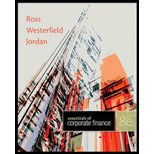
Essentials of Corporate Finance
8th Edition
ISBN: 9780078034756
Author: Stephen A. Ross, Randolph W. Westerfield, Bradford D. Jordan
Publisher: MCGRAW-HILL HIGHER EDUCATION
expand_more
expand_more
format_list_bulleted
Question
Chapter 15, Problem 15.9C
Summary Introduction
To determine: The primary argument against shelf registration
Introduction:
The registration that is permitted under the Securities and Exchange Commission (SEC) rule of 415 is a shelf registration. The shelf registration lets the firm to register all the issues that it wishes to sell within 2 years of time.
Expert Solution & Answer
Want to see the full answer?
Check out a sample textbook solution
Students have asked these similar questions
Need soln quic
Dear tutor finan
Need soln
Chapter 15 Solutions
Essentials of Corporate Finance
Ch. 15.1 - What is venture capital?Ch. 15.1 - Prob. 15.1BCQCh. 15.2 - Prob. 15.2ACQCh. 15.2 - Prob. 15.2BCQCh. 15.3 - Prob. 15.3ACQCh. 15.3 - Prob. 15.3BCQCh. 15.4 - Prob. 15.4ACQCh. 15.4 - Prob. 15.4BCQCh. 15.5 - Prob. 15.5ACQCh. 15.5 - Prob. 15.5BCQ
Ch. 15.6 - Prob. 15.6ACQCh. 15.6 - Prob. 15.6BCQCh. 15.7 - Prob. 15.7ACQCh. 15.7 - Prob. 15.7BCQCh. 15.8 - Prob. 15.8ACQCh. 15.8 - Prob. 15.8BCQCh. 15.9 - Prob. 15.9ACQCh. 15.9 - Prob. 15.9BCQCh. 15 - Prob. 15.1CCh. 15 - Prob. 15.2CCh. 15 - Prob. 15.3CCh. 15 - Prob. 15.4CCh. 15 - Prob. 15.5CCh. 15 - What has been presented as a reason why stock...Ch. 15 - Prob. 15.7CCh. 15 - Prob. 15.8CCh. 15 - Prob. 15.9CCh. 15 - Debt versus Equity Offering Size. In the...Ch. 15 - Debt versus Equity Flotation Costs. Why are the...Ch. 15 - Prob. 3CTCRCh. 15 - Prob. 4CTCRCh. 15 - Prob. 5CTCRCh. 15 - Prob. 6CTCRCh. 15 - Prob. 7CTCRCh. 15 - Prob. 8CTCRCh. 15 - Prob. 9CTCRCh. 15 - Prob. 10CTCRCh. 15 - Prob. 1QPCh. 15 - Prob. 2QPCh. 15 - Prob. 3QPCh. 15 - Prob. 4QPCh. 15 - Prob. 5QPCh. 15 - Prob. 6QPCh. 15 - Prob. 7QPCh. 15 - Prob. 1CCCh. 15 - Prob. 2CCCh. 15 - Prob. 3CCCh. 15 - Prob. 4CC
Knowledge Booster
Similar questions
- Company A has a capital structure of $80M debt and $20M equity. This year, the company reported a net income of $17M. What is Company A's return on equity?* 117.6% 21.3% 85.0% 28.3%arrow_forward12. Which of the following is the formula to calculate cost of capital?* Total assets/Net debt x Cost of debt + Total assets/Equity x Cost of equity Net debt/Equity x Cost of debt + Equity/Net debt x Cost of equity Net debt x Cost of debt + Equity x Cost of equity Net debt/Total assets x Cost of debt + Equity/Total assets x Cost of equity .arrow_forwardno ai .What is the enterprise value of a business?* The market value of equity of the business The book value of equity of the business The entire value of the business without giving consideration to its capital structure The entire value of the business considering its capital structurearrow_forward
- 10. The concept of time value of money is that* The cash flows that occur earlier are more valuable than cash flows that occur later The cash flows that occur earlier are less valuable than cash flows that occur later The longer the time cash flows are invested, the more valuable they are in the future The future value of cash flows are always higher than the present value of the cash flows .arrow_forward9. Which of the following is true when a bond is trading at a discount?* Coupon Rate > Current Yield > Yield to Maturity Coupon Rate < Current Yield < Yield to Maturity Coupon Rate = Current Yield = Yield to Maturity Coupon Rate < Current Yield = Yield to Maturity.arrow_forwardWhen the price of a bond is above the face value, the bond is said to be* Trading at par Trading at a premium Trading at a discount Trading below pararrow_forward
- 7. What is a par value of a bond?* The amount borrowed by the issuer of the bond and returned to the investors when the bond matures The overall return earned by the bond investor when the bond matures The difference between the amount borrowed by the issuer of bond and the amount returned to investors at maturity The size of the coupon investors receive on an annual basisarrow_forwardWhat is an annuity?* An investment that has no definite end and a stream of cash payments that continues forever A stream of cash flows that start one year from today and continue while growing by a constant growth rate A series of equal payments at equal time periods and guaranteed for a fixed number of years A series of unequal payments at equal time periods which are guaranteed for a fixed number of yearsarrow_forwardIf you were able to earn interest at 3% and you started with $100, how much would you have after 3 years?* $91.51 $109.27 $291.26 $103.00arrow_forward
arrow_back_ios
SEE MORE QUESTIONS
arrow_forward_ios
Recommended textbooks for you
- Business Its Legal Ethical & Global EnvironmentAccountingISBN:9781305224414Author:JENNINGSPublisher:Cengage
- Business/Professional Ethics Directors/Executives...AccountingISBN:9781337485913Author:BROOKSPublisher:Cengage
 EBK CONTEMPORARY FINANCIAL MANAGEMENTFinanceISBN:9781337514835Author:MOYERPublisher:CENGAGE LEARNING - CONSIGNMENT
EBK CONTEMPORARY FINANCIAL MANAGEMENTFinanceISBN:9781337514835Author:MOYERPublisher:CENGAGE LEARNING - CONSIGNMENT


Business Its Legal Ethical & Global Environment
Accounting
ISBN:9781305224414
Author:JENNINGS
Publisher:Cengage



Business/Professional Ethics Directors/Executives...
Accounting
ISBN:9781337485913
Author:BROOKS
Publisher:Cengage

EBK CONTEMPORARY FINANCIAL MANAGEMENT
Finance
ISBN:9781337514835
Author:MOYER
Publisher:CENGAGE LEARNING - CONSIGNMENT